This is often called “summer slump” and occurs with alfalfa but also, more severely, with cool-season forages like timothy, ryegrass, orchardgrass and fescue.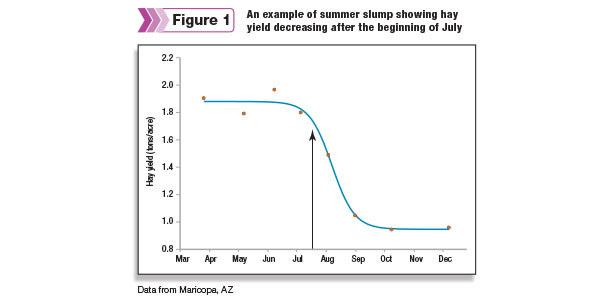
Definition and description
Summer slump is a decline in growth and yield of alfalfa usually beginning in July and continuing throughout the fall period. It’s most severe in areas where maximum daily temperatures exceed 90 to 100ºF, such as the low-elevation deserts of the Southwest (Figure 1).
In more temperate regions, there is a gradual decrease in alfalfa yield in successive harvests throughout the year, but the yield decline in the summer is not as sharp as in hot summer regions.
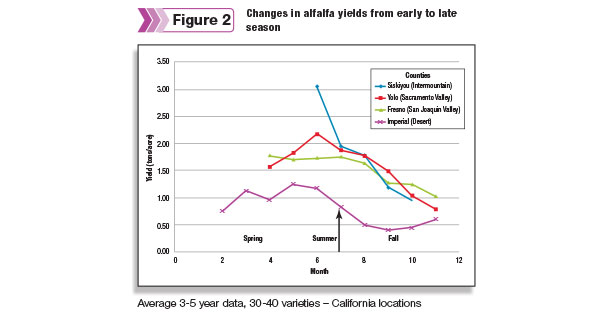
Figure 2 shows the reduction in month-by-month yields at the cooler, short-season intermountain site (Siskiyou County), the hotter Central Valley sites (Yolo, Fresno counties) and the very hot desert site (Imperial County) in California (Figure 2) and Arizona (Figure 1). These yield reductions occur mostly after July.
Causes
Summer slump is associated primarily with high temperatures that occur in the summer, and secondarily to shorter days and fall dormancy response that occur during late summer and fall periods.
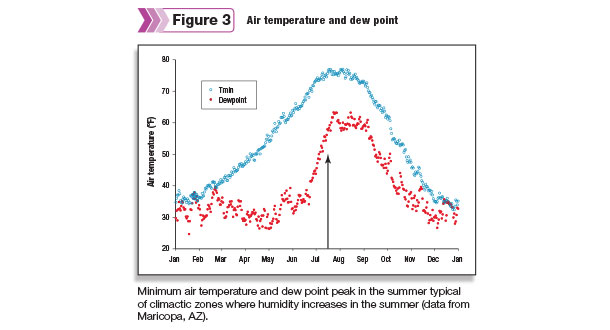
Most likely, high night temperatures and high humidity contribute significantly to summer slump in Southwest areas (Figure 3).
Alfalfa is a cool-season crop that can be fairly productive in hot climatic zones if the air is dry since leaf temperature can be almost 20 degrees below air temperature under these conditions.
However, when the humidity in the air increases, the cooling effect of water loss from the leaves is reduced. This means leaf temperatures can climb well above the optimum for plant growth and photosynthesis.
The leaf stomata (tiny holes in the leaves which allow CO2 to enter for photosynthesis) are closed, reducing the production of carbohydrates through photosynthesis.
Also, respiration increases during warm weather, rapidly using up carbohydrates, which reduces growth and yield.
The shorter days and fall dormancy response may also be an important cause of summer slump in some areas. After the summer solstice on June 21, day length becomes increasingly shorter, reducing available solar radiation but also causing physiological changes in the plant to favor root versus shoot growth (also known as the fall dormancy response).
The fall dormancy response is the reduced growth in the fall due to decreasing day length (and to reduced temperatures).
Fall dormancy response is most apparent in dormant varieties, but some reductions in growth can also be seen in non-dormant varieties.
It’s interesting to note the differences between regions (Figure 2), but all regions show late-summer yield declines. Generally, non-dormant varieties are grown in central and southern California and Arizona, but dormant lines are grown in intermountain northern areas and throughout the Midwest.
Impacts of summer slump
Yield
The most important effect of summer slump is on yield. Hay yield per cutting during summer slump may be reduced by half compared to the spring periods.
This reduction in yield is due to reduced plant height, leaflet size and number of stems produced per plant, and lower growth rates during this period.
Root carbohydrates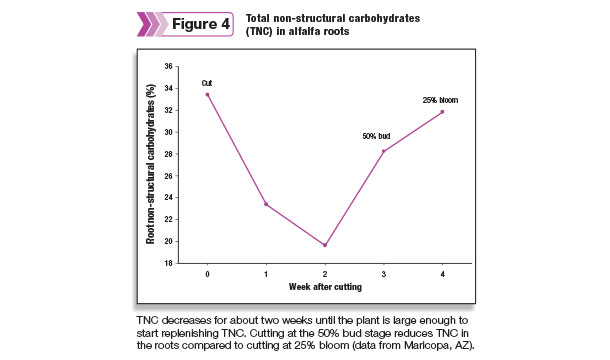
The alfalfa plant uses carbohydrates (sugars) stored in the root to re-grow after cutting. Typically, root carbohydrates are drawn down for about two weeks after cutting, at which time the plant is large enough to produce enough carbohydrates to start replenishing the root reserves to be used in the next re-growth cycle (Figure 4).
Cutting early (e.g., at the bud stage) results in a decrease in root carbohydrate concentration in successive cutting cycles.
High temperatures during the “monsoon” season (which occurs in the Southwest) further reduce root carbohydrate concentration due to increased respiration.
Thus, growers interested in sustaining their plant stands may want to consider lengthening their summer harvest period beyond the 28-day period to increase stored root carbohydrates.
Premature flowering
During mid-summer and late-summer periods, alfalfa plants often flower when less than a foot in height during summer slump, and yield is reduced not only by lack of height in the plant but also by reduced stem numbers (tillers).
This response may be due to water stress or the combined effects of low root carbohydrates and high temperatures.
Quality
Alfalfa produced during the summer slump usually is low in quality and suited only for dry cows, feedlot animals or horses. In recent years, this hay has been increasingly exported.
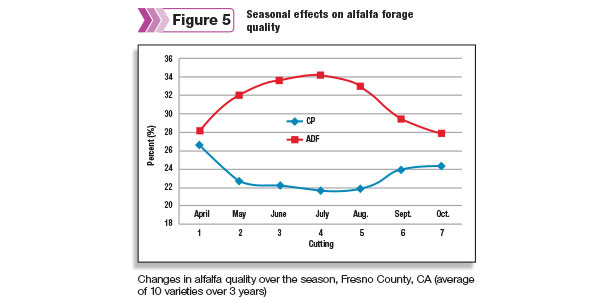
Alfalfa hay produced in the spring or late fall is typically suited to lactating dairy animals. Fiber concentration (NDF and ADF) is highest and crude protein is lowest after June and throughout the late summer, and quality improves in the late fall under cooler conditions (Figure 5).
Note that although quality improves in the fall, yield often does not. Quality is lower during this late summer period for two reasons: Generally, leaf percentage in the hay is lower during mid-summer harvests (leaves are small), and additionally, the soluble carbohydrates are rapidly metabolized due to the high temperatures.
These dual factors result in higher ADF and NDF (fiber) contents and lower protein contents during the summer periods.
Management factors can help lessen summer slump impact
Although completely eliminating alfalfa summer slump may not be possible, some factors can lessen its impacts on the crop. Management practices most likely to have an effect on summer slump are irrigation and harvest interval.
Varieties
It has been suggested that more fall-dormant varieties are more resistant to the conditions that cause summer slump, and there is some experimental evidence to support this theory, although the effect may be small.
However, growing varieties with more fall dormancy than required for an area for a small increase in yield during summer slump may not warrant the loss in yield during the fall. Generally, growers should choose those varieties that are superior in total yield potential.
Irrigation
Water stress can worsen the effects of summer slump and even cause the plant to flower prematurely as previously mentioned. Keeping the crop well watered is one of the few management practices a grower can use to delay or lessen the effects of summer slump.
However, it should be noted that alfalfa water use is reduced during summer slump due to decreased growth. Also, water standing for more than 24 hours when the high air temperature is above 100ºF can lead to scald injury.
Terminating irrigation during summer slump is an alternative management strategy that may be economical depending on costs of production and the value of the hay produced.
This is called “deficit irrigation” or “summer drydown” and may make sense for growers if yields are very low and the water has better uses elsewhere or is in short supply.
Calculations of partial net returns should be made which consider cost of water, harvest and pest management during these summer harvests to make sure deficit irrigation is worthwhile.
Fertilization
Fertilizer application is not expected to affect summer slump unless the crop is nutrient-deficient. The nitrogen-fixing ability of root nodules probably do not contribute to summer slump, and these nodules are not affected by high temperatures because most are found at a 4-inch to 12-inch depth where soil temperatures are optimal for nodule functioning.
Response of alfalfa to nitrogen fertilizer during summer slump has not yielded consistent results.
Weeds
Alfalfa is less competitive with weeds during the summer slump compared to other times of year due to the relative growth of the crop compared to weeds.
Summer annual grasses, such as bermudagrass, watergrass and nutsedge, can be particularly competitive with alfalfa during summer slump. Herbicides are available to control these weeds, but are not as effective when alfalfa is more vigorously growing.
Insects
Insects should be controlled during summer slump to reduce stress on the plant and maintain quality. Insects, especially sap feeders such as potato leafhopper and three-cornered hopper, reduce crop growth and contribute to low yields during the summer slump.
Control of multi-host insects (e.g., Lygus bugs, potato leafhopper and stink bugs) in alfalfa may be necessary to avoid population build-up and movement to other crops.
Diseases
Any disease has the potential to contribute to the negative effects of summer slump. Rhizoctonia and other diseases that affect the root may compromise the ability of the crop to take up water and contribute to reduced yield during the summer slump period.
Chemical control of diseases in alfalfa is generally not economical. Avoidance through good sanitation of equipment and elimination of water standing for more than 24 hours is recommended to reduce the risk of plant disease outbreaks.
Cutting height
A cutting height of about 1 to 2 inches is generally recommended for alfalfa cut at the early bloom stage that is not under stress or depleted in root carbohydrates.
However, when harvesting frequently, such as in the bud stage, cutting at 4 inches compared to 1 inch may slow the decline in stand and root carbohydrate but not significantly affect yield.
Raising the cutting height has the added advantage of increasing hay quality since less stem is harvested.
Harvest interval
Cutting alfalfa before the bloom stage is a common practice to obtain the desired hay quality. This practice puts stress on the plant and contributes to summer slump and reduced stand life.
Cutting at full bloom during the summer will replenish the root carbohydrate reserves, reduce the effects of summer slump and increase the probability of a rebound in yields in the fall.
Although there are no magic solutions to heat and summer stress, keeping the crop well irrigated and changing harvest schedules are likely some of the most important things growers can do to deal with the summer slump. FG
Mike Ottman and Ayman Mostafa are with the University of Arizona, and Dan Putnam is with the University of California.









